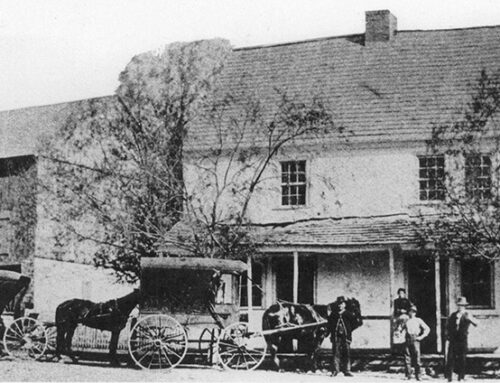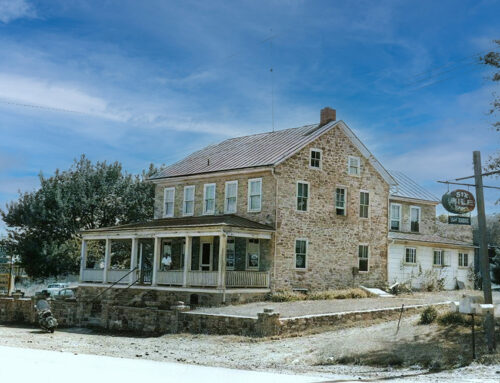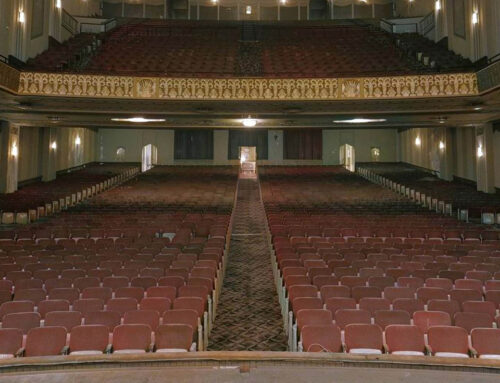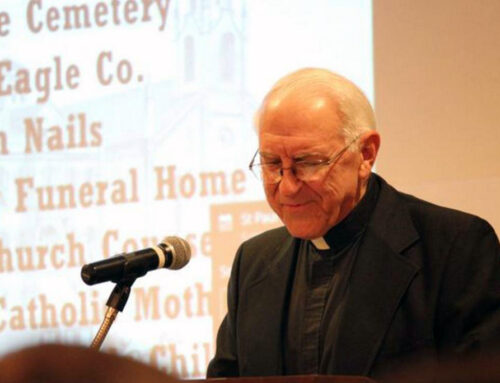Theodore Ignatius Heizmann began the construction of St. Cecilia’s Chapel in 1892-1893 in memory of his mother, Mary Cecilia Heizmann.
Theodore Ignatius Heizmann was born in Reading Dec. 14, 1838. He attended the private schools of the city and later Mount St. Mary’s College, at Emmitsburg, Md., where he remained two years, after which he entered the Rensselaer Polytechnic Institute at Troy, N. Y., in 1856. He graduated in 1859, with the degree of civil engineer, and for several months thereafter was engaged as assistant to the topographer of the preliminary survey of the Reading & Columbia railroad, and in a similar capacity on the survey of a line between Easton and Nazareth. In March, 1860, he became a member of the engineer corps of the Pennsylvania Railroad Company, and by his industry and ability won such rapid promotion that in March, 1861, he became assistant engineer. In March, 1864, he became principal assistant engineer, and in February, 1865, became resident engineer of the Middle division, from Harrisburg to Altoona, his office being at the latter place. In January, 1868, he became resident engineer of the Philadelphia division, between Philadelphia and Harrisburg, with office at Philadelphia. In April, 1870, his office was changed back to Altoona, when he was made engineer of maintenance of way of the main line between Philadelphia and Pittsburg. In January, 1872, he was appointed chief engineer of maintenance of way of all lines of the Pennsylvania Railroad Company between New York City and Pittsburg, and as such had his office at Philadelphia until his retirement in 1874. After retiring, Mr. Heizmann spent much of his time in foreign travel. He took keen enjoyment in music and even during his active business career kept up his musical studies for the love of the art. He was vice-chairman of the music committee during the Sesqui-Centennial celebration in June, 1898, and wrote the music for the hymn sung on that occasion. He had been vice-president and a director of the Penn Hardware Company since its incorporation. In 1892-93 he built the St. Cecilia Memorial Chapel at the northwest corner of Perkiomen Ave. and Spruce Street, as a memorial to his mother Mary Cecilia (Eichhorn) Heizman. After suffering for over three years with a complication of diseases, Theodore Ignatius Heizmann, aged 71 years, 2 months and 19 days, died at his home, 1249 Eckert Ave., at 9 p.m. on March 2, 1911.
Mary Cecilia Eichhorn, daughter of John Francis Eichhorn and Eva Siegfried, whose ancestors settled in Berks county in 1755, married Charles Lawrence Heizmann on April 22, 1834. All of their children were born in the old family home, on the southeast corner of Sixth and Penn streets, Reading.
Below: Heizman Building, Southeast corner of Sixth and Penn Streets, Reading, 1845. The Heizmann family agreed to lease the property to Pomeroy’s department store beginning in November 1899.

Mrs. Heizmann was one of a family of five children, namely: Anna, who married a New England schoolmaster, Jonathan Dwight; John Francis, who was married to Matilda Miller (both died at an early age, leaving two daughters, Alice and Ann) ; Ellen, who married Charles Troxell, postmaster of Reading under the Harrison-Tyler administration, and a collector of the Port of Philadelphia under the Taylor-Fillmore administration; Mary Cecilia; and Theresa, who married Dr. Adolphus Lippe, a son of the Count of Lippe-Weissenfeldt, Germany, and a member of the Lippe-Detmold family. Six sons and two daughters were born to Mr. and Mrs. Heizmann and the family was influential and active in both professional and industrial circles in Berks county for many years. Charles Raymond and Theodore Ignatius (mentioned above). Francis Joseph, born Aug. 14, 1841, died Oct. 22, 1849. Cecilia Eve was born June 2, 1844. Dr. Charles Lawrence and Albert Aloysius are mentioned below. Mary Ann, born Nov. 4, 1853, became the wife of James A. O’Reily, Esq., a prominent attorney of Reading. Aloysius Adolphus, born Sept. 27, 1858, died Feb. 17. 1859.
St. Cecilia Memorial Chapel Dedication
The chapel was dedicated on November 22, 1895. The day was selected for the consecration because it is known on the church calendar as St. Cecilia day and was considered an appropriate occasion.
The imposing ceremonies, at which many visiting clergy attended, was directed by Reverend George Bomemann of St. Paul’s Church. After the blessing of the chapel, a Solemn Mass was celebrated by the Rev. Dr. J.J. Koch of Shamokin, who was Vicar General of the Harrisburg Diocese. Rev. John Seimetz of Catasauqua acted as deacon, and Rev. Henry Gantert of Norristown was sub-deacon. The Rev. Father Michel, at that time assistant at St. Paul’s Church, Reading, was Master of Ceremonies. The sermon was delivered by Rev. James Maus of Allentown.
The chancel of the handsome sanctuary was lavishly decorated with white and yellow chrysanthemums and smilax. Candles and incense burned during the service. The auditorium accommodates about 300 persons and it was crowded to its utmost. Relatives of the Heizmann family were present from other cities, and it was an occasion of the greatest interest to all concerned.
The chapel was attended by the priests of St. Paul’s R.C. Church, 151 North Ninth Street, Reading, PA.
Description of the Original Edifice
The chapel is a handsome and substantial brownstone structure of rustic, Gothic architecture. It is 34×66 feet, with a tower at the corner 12 feet square.
The interior is finished in natural wood, the ceiling being open timber work of yellow pine and the altar, screen, sanctuary railing and gallery front of oak. The pews are quartered oak arranged with the aisles on the sides of the chapel and accommodating about three hundred people.
The large stained glass window in the east end of the chapel, the gift of Miss. Heizmann and Mrs. James O’Reilly, daughters of Mary Cecilia Heizmann, contain the pictures of the four Evangelists. In the middle is the figure of St. Cecilia which is as exact copy of Raphael’s celebrated picture in the Accademia della Belle Arti-Bologna, Italy. The stained glass side windows are adorned with emblems exemplifying the Christian Virtues of peace, purity, martyrdom, etc., were made in Munich, Germany. The vestments, which were made in Lyons, France, were also the gift of Miss Heizmann.
There is a marble memorial tablet upon which is engraved “To the glory of God and in beloved memory of Mary Cecilia Heizmann, born May 13, 1812: died July 19, 1891.” This chapel has been erected by her son, Theodore Ignatius Heizmann.

The vestments, which were made in Lyons, France, were also the gift of Miss Heizmann. The oak altar and screen are the gift of James A. O’Reilly: the chalice and ciborium of C. R. Heizmann; the altar, candlesticks of Dr. C. L. Heizmann, and the sanctuary lamp of A. A. Heizmann.
1914 Improvements and Description of Edifice
In 1914, extensive improvements to St. Cecilia’s Chapel were completed. The edifice was consecrated by Archbishop Prendergast, of the Philadelphia archdiocese.
An extension to the rear was erected. This addition was necessitated by the steady increase of the attendance at Sunday masses. The $3,000 cost for improvements were defrayed by Miss Cecilia Heizmann. The addition was constructed of brownstone by contractor Daniel H. Hunter. William Fink was the architect.
Art glass windows, imported by Miss Cecilia Eva Heizmann, a sister of the donor of the church, were made by Meyer Brothers, in Milan. The large window on the Perkiomen Ave. front portrayed St. Matthew, St. Mark. St. Luke and St. John.
Erects Memorial Altar
Miss Cecilia Eva Heizmann had a new altar erected as a memorial to her brother, Theodore Ignatius Heizmann. The altar was built in Italy of marble from the famous White Rutland quarries, and the only suggestion of color comes in the four columns at the base, which are of Rubio marble. In design it follows closely the Gothic style of architecture, in harmony with the Gothic design of the church. The Sacred Heart figure stands forth prominently in the central section, while the main panel under the Mensa the letters I. H. S. are raised in full relief. In each of the end panels under the Mensa is a cross enclosed in a circle. These are also raised. The tabernacle door is of bronze, all in satin finish save the chalice portion, which has the smooth gold finish. The following inscription Is carved at the base of the altar:
In memory of Theodore Ignatius Heinzman. Pray for him. Erected by his sister, Cecilia.

The main altar was built on constructional iron work resting on a solid concrete base, and weighs 12 tons. The altar was built by the Vermont Marble Company at their Center Rutland plant, and was erected under the supervision of Architect William A. Fink, 426 Franklin street, who also designed and supervised the erection of the new sacristy built In the rear of the sanctuary, and made the plans for St. Cecilia Church when it was erected. No expense was spared by Miss Heizmann in making these improvements which served as a fitting memorial to her beloved mother and brother.
St. Cecilia Memorial Chapel Closed
St. Cecilia’s Chapel was closed by St. Paul’s R.C. Church due to increased costs of maintenance, and many of the cherished artifacts were taken to a new mausoleum at Gethsemane Cemetery. The pews were removed and refurbished and installed in the Gethsemane Cemetery Chapel of the Resurrection. Stained glass windows were also removed and placed in the Chapel and Atrium sections. The Stations of the Cross were relocated in the St. Joseph section of the new mausoleum at Gethsemane Cemetery.
St. Cecilia Memorial Chapel Sold
The chapel was sold to Total Family Christian Center Inc., on April 1, 1999 for $55,000. On Dec. 12, 2017, a lien was recorded against Total Family Christian Center Inc., against the chapel property at 1340 Perkiomen Ave., Reading, Docket No. 1720620, in the amount of $394.06.
At some point the chapel was abandoned by Total Family Christian Center Inc. Fires and neglect compromised the structural integrity of the brownstone church to the point of partial or complete demolition.
Touch or Click Image to Enlarge.
Reading City Council Strategic Planning Committee Meeting on Blight
During a Strategic Planning Committee meeting on March 6, 2023, Mr. John Miller, former Reading Redevelopment Authority (RRA) Chair, addressed Reading City Council. He stated that he spoke at a Council meeting in December to request funding for blight remediation. He stated that the RRA now has a blight strategy and they need funding for implementation of the strategy. Mr. J. Miller described the Blighted Property certified list which has been growing since 2008. He noted that in the past only even (7) certified properties were put through an acquisition process by the RRA. He spoke about the RRA’s Blight Strategy and the work the RRA is doing to develop Standard Operating Procedures (SOPs) to implement that strategy which will require a funding source.
In response to a question from former Reading City Councilwoman Ms. Goodman-Hinnershitz, Mr. J. Miller stated that the RRA plays a key role in the Blighted Property process. The certified properties are a mix of residential and commercial properties. He stressed the need for government intervention after properties are certified as blighted so the properties can be transferred to new owners through eminent domain or some other acquisition approach with a requirement for rehabilitation within a defined amount of time recorded on the deed.
Mr. J. Miller stated that approximately 50% of the certified properties are owned by absentee landlords and the City Property Maintenance Division does nothing to hold them responsible or accountable.
Mr. McMahon of (RRA) stated that the $1M in blight remediation funding that Council allocated a few years ago could be allocated to the RRA to help them get started. He noted too, that there is also approximately $4M in HUD funding available to move this initiative forward. He stated that community development attracts economic development and the $1M allocated for blight remediation can help get the community development moving forward.
Ms. Goodman-Hinnershitz asked the RRA to submit a project timeline to implement the Blight Strategy. She agreed that doing nothing contributes to the blight problem and used the recent fire at the Mineral Spring Hotel as an example.
Mr. Miller agreed, adding the former church located at 1340 Perkiomen Ave. as a 2nd example due to the recent fire call resulting from the activities of a squatter at this property. He stated that this brownstone property sits on a triangular parcel. He stated that the steeple has already collapsed and the structure remains in a compromised position. He suggested a planned demolition and saving the brownstone for reuse. He noted that the City does well at placing orange placards on blighted or structurally compromised buildings but does not follow up and demand compliance.
The partial demolition and potential loss of St. Cecilia’s Chapel due to its irresponsible owners is unacceptable. Cities should have greater legal options for seizing abandoned or blighted properties and residences.















Leave A Comment